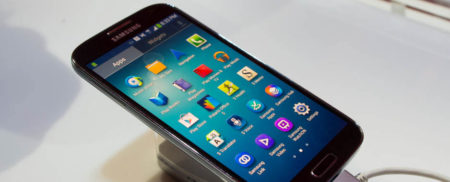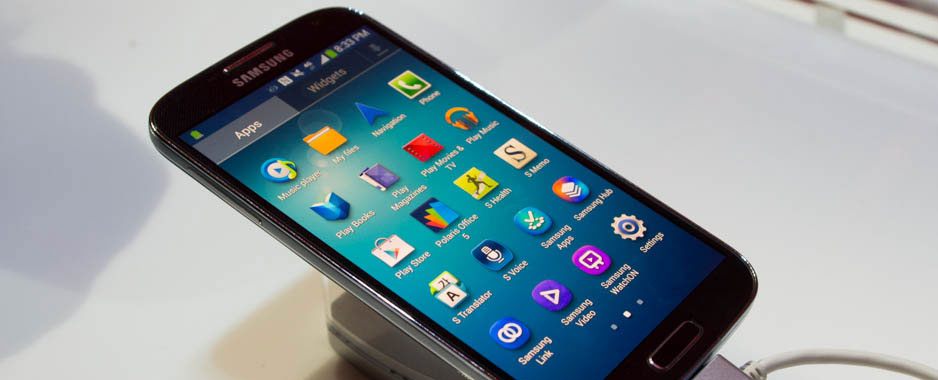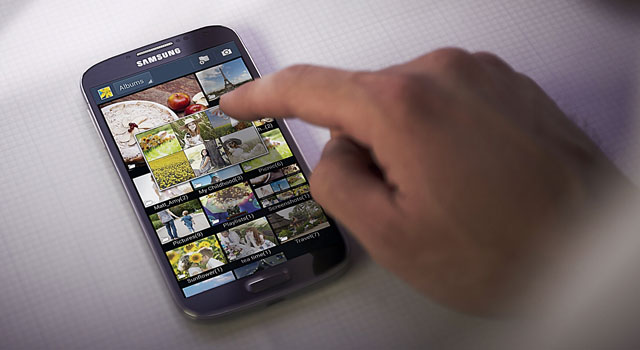
Samsung Electronics’ Galaxy S3 was the runaway success in Android smartphones over the past year, selling more than 50m units by mid-March 2013, exceeded only by Apple’s iPhone.
So, you’d think the consumer electronics giant would have waited a little longer than it did to release the S3’s successor, allowing it to milk its cash cow for that little bit more. Nope, not these Koreans — Samsung took the wraps off the S4 at a glitzy launch in New York in March, just nine months after the S3’s debut. And, boy, it’s a worthy successor!
For a device that’s following so soon after its predecessor, the S4, while iterative in some areas, has made big leaps forward in others. So much so, that this publication is of the view that the S4 has taken the crown (for now, at least) as not only the best Android-powered smartphone in the world, but also the best smartphone overall, narrowly edging out HTC’s new One and Sony’s Xperia Z (in part because of the S4’s superior battery), and leaving the iPhone 5 looking quite dated. Yes, the S4 represents a big problem not only for other other Android smartphone manufacturers, but also for Apple, which has fallen behind the innovation curve.
Like other top-end Android smartphones, the most noticeable feature of the S4, when one takes it out of the box for the first time, is the screen. Packing in an incredible 1 920×1 080-pixel screen — for a pixel density of 441ppi across its 5-inch Super Amoled screen — the resolution is noticeably better than on the S3. Text is crisper and high-res photos almost jump out at you.
Of course, like rival Android phones, there is some controversy about the size. “It’s so big,” is a comment we’ve heard a few times while reviewing the S4. At five inches, the phone’s screen has expanded by 0,2 inches over its predecessor, taking it closer to “phablet” (phone-tablet hybrid) territory. Ultimately, screen size is a matter of personal preference. We think Samsung and other Android phone makers have found the sweet spot at this size and we find going back to a 4-inch display, such as the one found on the iPhone 5, rather painful.
It must be noted, too, that despite the increase in screen real estate over the S3, the S4 is roughly the same size overall as its predecessor and, remarkably, at just 130g, it’s even a couple of grams lighter. It’s quite a feat of engineering.
The kitchen sink
Before we get to the software features that Samsung has crammed into the TouchWiz-adorned Android 4.2.2 that ships with the S4, it’s necessary to spend some time talking about the hardware — there’s lots of it — that the company has crammed into the device.
There’s all the usual stuff you’d expect, from high-speed 3G with download speeds of up to 42Mbit/s (a 4G version, which we haven’t reviewed, will go on sale in a few weeks’ time) to support for the latest Wi-Fi standards, including 802.11n and 802.11ac, and from an assisted GPS to an accelerometer.
There’s also some stuff you might not expect — an eight-way processor clocked at 1,9GHz, a gesture sensor (which Samsung has put to good use), and even a thermometer and a hygrometer (adding to the barometer found in the S3). Weather geeks, rejoice!
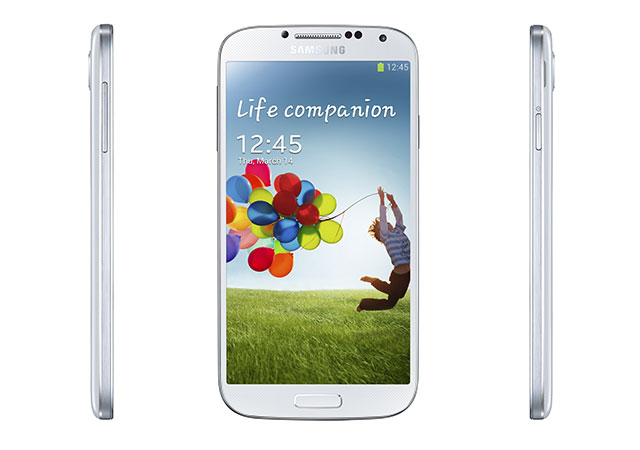
Then there’s the battery. The 2 600mAh monster in the S4 delivers the best performance we’ve seen to date on a large-screen smartphone. The battery life is all the more impressive given the increased screen size and display resolution. Samsung has clearly expended a great deal of effort in making sure the software is optimised to use as little power as possible — the S3 seems like a fuel-hungry Land Cruiser next to the Prius-like S4.
We easily lasted a full day of moderate to heavy use of the S4. It is unlikely average users will need to seek the power outlet until well into the evening, even after a heavy day’s use. This is a major selling point of the S4, and, in our view, has allowed Samsung to pull ahead of HTC with its new One, which beats the S4 in some other respects — most notably in design styling and audio quality — but which is let down by its comparatively weak battery.
Where HTC wins in this generation of smartphones is with its audio output quality. The Taiwanese firm, which struggled to gain traction against the S3 with its 2012 model, the One X, has outdone itself with its latest model, which offers the best sound we’ve heard on any smartphone, thanks in part to the integrated Beats Audio chipset. The One’s front-facing stereo speakers produce rich, high-quality sound, so you’re not left scrambling for your headphones the moment you fire up a music playback application. Though the S4’s single, rear-facing speaker produces adequate sound, it’s no match for the HTC One’s output. The trade-off, then, is between great audio and good battery life.
Then there’s the S4’s ability to act as a universal remote control for the lounge. While we managed to get it to pair with a flat-screen television made by LG Electronics — successfully getting the TV to switch on and off and change channels and volume — we had no luck at all trying to pair it with a DStv PVR decoder, despite DStv parent MultiChoice being listed as an option in the menus. Similarly, trying to hook it up to a Panasonic DVD carousel system was not successful.
Lights, action, camera
The Galaxy S3 had one of the best cameras to grace an Android phone and Samsung’s outdone itself with the shooter on the S4. Although its 13-megapixel sensor sounds excessive, especially as most users have come to understand that megapixels are just one of many measures that make for a good camera, with the S4’s glorious display the extra sensor resolution is welcome.
Samsung’s paid a lot of attention to its camera business in recent years, leaving the established players to compete in the high-end digital SLR space while it focuses on the compact market. It’s even gone so far as making an Android-powered touch-driven camera, the Galaxy Camera. This experience shines through on the S4.
The S4’s camera caters just as well for users who literally want to point and shoot as it does for those who want a large amount of control. The automatic mode, set by default, is adept at accounting for all manner of lighting conditions, the auto-focus is speedy, and it’s possible to take rapid-fire shots in almost instant succession.
Like other recent Android devices, the S4’s camera offers users on-screen buttons to capture a still picture or begin recording a video at any time. The S4 captures excellent 1080p video at 30 frames per second and the built-in stabilisation is surprisingly effective. The vast majority of users will be able to leave the camera to make all of the key decisions and still get excellent results.
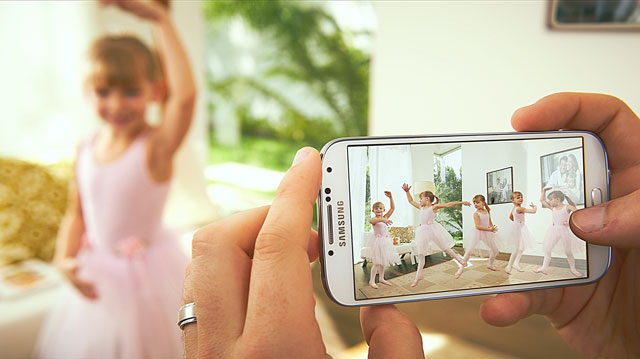
Those who really want to can set every important aspect of the camera manually. Of course, each new device needs new features and Samsung’s jammed plenty into the S4’s camera app. Some, like “Best Photo” and “Best Face” are features we’ve seen before. Both take a number of images in quick succession and allow the user to choose the best image, or part thereof, from the selection. Now there’s also the ability to include the photographer in shots by means of the front-facing camera and a moveable, scalable on-screen window. It’s a bit of a gimmick, but it’s undeniably novel.
The option to capture a high number of frames in quick succession also allows for a range of multimedia-based features. For example, users can animate portions of stills, or add audio to them, or even erase moving objects — like passers-by — from stills after capture. It’s also possible to capture multiple instances of a moving subject in one composite image, as illustrated in the image above.
Much like the rest of the S4, the camera can meet the demands of all sorts of users, from the insatiable tinkerer to the casual shooter. We’d have liked a dedicated shutter release button — instead, the volume rocker controls the digital zoom — but with so much screen real estate to play with, it’s a minor gripe.
Features galore
That the S4 is packed with software features is an understatement. Samsung has crammed so much into this device that the average user will probably not even get around to trying it all. This has elicited criticism from some quarters, with some reviewers saying that the company has taken a spray-and-pray approach to the feature set, hoping that some of it sticks.
Samsung itself appears concerned that some users will be overwhelmed by it all, so it’s included an “easy” mode, which hides many of the features. We’re not convinced this is the right approach: if, as an end user, you’re not comfortable with a complex feature set, you really shouldn’t be wasting your money on a top-end phone like this. If all you’re after are the features offered in the S4’s pared-down mode, we’re sure a certain Mr Elop would be more than obliging in offering you a (much cheaper) Nokia Asha instead.
We’d much rather have the features, even if some of them appear superfluous. Besides, we’re certain some users will find them useful. Few users, we suspect, will take advantage of the “Smart Scroll” feature, for instance, but no doubt there are those that will find it useful.
Other features, like “Air View”, which allows you to preview information, such as the contents of a text message or e-mail by hovering a finger over the screen without actually touching it, will clearly have mass appeal. Another one that will no doubt be used by many S4 buyers is “Voice Control”, which offers the ability, for example, to snooze or stop an alarm simply by saying “stop” or “snooze” — amongst many other things.
There’s the gamut of Samsung apps, including the S Planner diary and the S Voice personal assistant, both of which were bundled with the S3. S Voice, which is Samsung’s rival to Siri, has improved vastly since it was launched a year ago — it’s actually quite usable now, for the most part, for barking out basic instructions. It still gets things wrong, but “Call mom on her mobile phone” or “Set an alarm for 8am” work well. S Voice has also become a lot more diplomatic. Ask it, for example, what it thinks of Siri, and it says: “I hope she’s doing well and enjoying herself out there.”
Then there’s S Translator, which, although it duplicates to some extent the features already available in Google’s Translate Android app, offers “high-definition” voice downloads for high-quality playback in English, Spanish, Italian, German, French and Brazilian Portuguese. It should prove very useful for travelling in Europe.
A new Samsung app on the S4 is S Health, which is meant to “help users manage their overall health and wellbeing through capturing and tracking health-related information and metrics”. It’s fine for basic measurement of distance walked or run and calories burnt, but people serious about their exercise will still want to use an app like Strava or RunKeeper, or a specialised GPS sports watch.
The feature list goes on: you can connect multiple S4s wirelessly to output the same playback source, so that you can, for example, fake a surround sound system (could be useful at parties where most of the guests are geeks), or you can turn on a much-improved driving mode, which offers a reduced set of (voice-driven) controls for when you’re behind the wheel. You get the picture.
In conclusion
Although Samsung has been criticised for using a similarly cheap plastic rear cover as found on the S3, the overall design of the new phone is vastly improved. Though there’s no mistaking this as a Galaxy device — and as the successor to the S3 — the Korean firm has made a number of refinements that make the new model much more polished. It’s not quite as refined as the iPhone 5 or the HTC One, but it’s greatly improved.
In our experience, the plastic rear cover is far from being the deal breaker some reviewers have suggested. After all, no one spends time looking at the back of their phone. And for some people, the fact that the battery is user replaceable — unlike on the Apple iPhone, HTC One or Sony Xperia Z — is an important differentiator. For one thing, it extends the useful life of the phone. For another, it allows those away from electricity for an extended period of time to carry spare batteries and remain connected.
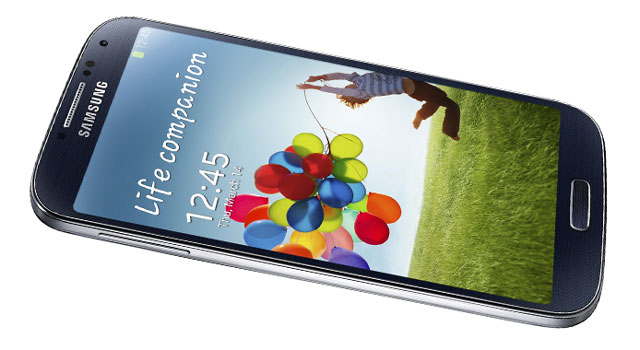
It’s hard to find much to fault in the Galaxy S4. Though it’s not quite as good looking as, say, the HTC One, it more than makes up for this with its extensive feature set and its decent battery life.
But Samsung has one more trick up its sleeve for those who can’t make up their minds about what to get: consumers who buy the S4 get a 24-month warranty that includes two free repairs or replacements in the case of accidental damage. The cover extends to damaged screens and water damage — no questions asked — and is available in all markets in Africa.
In TechCentral’s view, the Galaxy S4 has edged out its rivals, taking the title of best smartphone of 2013 so far. Samsung’s 24-month warranty gives it the definitive lead. The S4 is the phone everyone else now has to beat. — (c) 2013 NewsCentral Media
- The Galaxy S4 is available from Vodacom, MTN, Cell C and Telkom Mobile/8ta. Expect to pay about R8 500 outside of a contract
- The S4’s camera was reviewed by Craig Wilson


